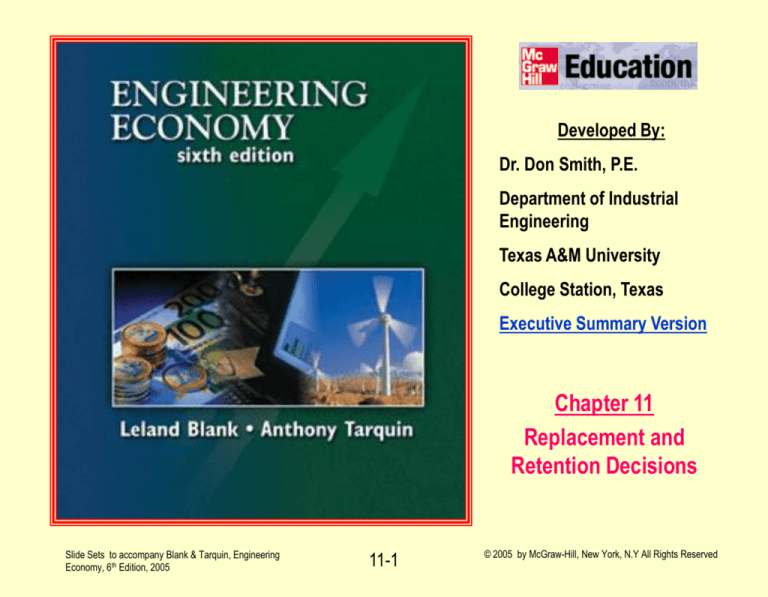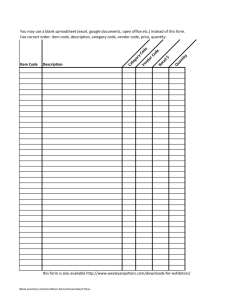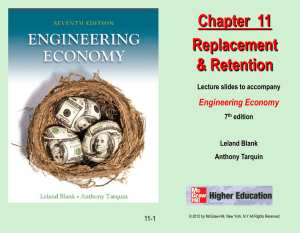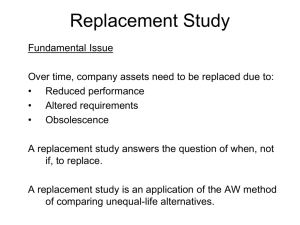
Developed By:
Dr. Don Smith, P.E.
Department of Industrial
Engineering
Texas A&M University
College Station, Texas
Executive Summary Version
Chapter 11
Replacement and
Retention Decisions
Slide Sets to accompany Blank & Tarquin, Engineering
Economy, 6th Edition, 2005
11-1
© 2005 by McGraw-Hill, New York, N.Y All Rights Reserved
LEARNING OBJECTIVES
1. Basics
2. Economic service
life
3. Replacement
study
4. Additional
considerations
5. Study period
Slide Sets to accompany Blank & Tarquin, Engineering
Economy, 6th Edition, 2005
11-2
© 2005 by McGraw-Hill, New York, N.Y All Rights Reserved
Sct 11.1 Basics of Replacement Study
Reduced Performance:
Wear and tear
Decreasing reliability and productivity
Increasing operating and maintenance costs
Altered Requirements:
New production needs, accuracy, speed, etc.
Obsolescence:
Current assets may be less productive
Not state of the art – need to meet competition
Slide Sets to accompany Blank & Tarquin, Engineering
Economy, 6th Edition, 2005
11-3
© 2005 by McGraw-Hill, New York, N.Y All Rights Reserved
Terminology
Defender Asset:
Currently installed asset;
Challenger Asset:
The potential replacement or “challenging” asset;
Under consideration to replace the defender asset.
Together, Defender (D) and Challenger (C)
Constitute mutually exclusive alternatives;
Select one and reject the other.
Slide Sets to accompany Blank & Tarquin, Engineering
Economy, 6th Edition, 2005
11-4
© 2005 by McGraw-Hill, New York, N.Y All Rights Reserved
Terminology - continued
AW values are typically calculated
EUAC –Equivalent Uniform Annual Cost
Includes mostly costs estimates
Economic Service Life (ESL)
For a given alternative is:
Number of years at which the lowest AW-of-cost occurs
Defender First Cost
Initial investment in the defender – P
Current Market value now – correct estimate to assign
to keeping a defender
Slide Sets to accompany Blank & Tarquin, Engineering
Economy, 6th Edition, 2005
11-5
© 2005 by McGraw-Hill, New York, N.Y All Rights Reserved
Terminology - continued
Challenger first cost
Amount of capital that must be recovered when replacing a
defender with a challenger
Sunk cost
Cost that has occurred in the past and cannot be altered
Sunk costs are generally of no use in a before-tax
replacement analysis
Consultant’s viewpoint
The analyst assumes that he/she is an outsider (a consultant)
Thus, the analyst owns neither asset and must assign
reasonable value to the defender and challenger
Slide Sets to accompany Blank & Tarquin, Engineering
Economy, 6th Edition, 2005
11-6
© 2005 by McGraw-Hill, New York, N.Y All Rights Reserved
The Proper Viewpoint
For a replacement analysis two investment costs
are critical:
1.
The proper investment cost to apply to keeping the
defender in service;
2.
The proper investment cost to apply to any
challenger asset that might replace the current
defender asset.
While it may seem strange to charge an investment cost for keeping one’s own asset
(the defender) this is what must occur. Keeping the defender is not free! Why?
Because the firm is giving up the opportunity to receive a possible cash flow from
selling the current defender.
Slide Sets to accompany Blank & Tarquin, Engineering
Economy, 6th Edition, 2005
11-7
© 2005 by McGraw-Hill, New York, N.Y All Rights Reserved
Investment Concerns
One must assign an investment cost to KEEPING
the defender asset
The appropriate investment cost to assign to the
defender asset is:
The current fair market value of the defender at the
time the replacement decision is being examined.
Challenger Investment
This is the total investment (Pchallenger) required for a new
(challenger) asset that will possibly replace the current
defender.
Slide Sets to accompany Blank & Tarquin, Engineering
Economy, 6th Edition, 2005
11-8
© 2005 by McGraw-Hill, New York, N.Y All Rights Reserved
Sct 11.2 Economic Service Life (ESL)
ESL is:
Number of years n at which the equivalent annual
worth (AW) of costs is minimized considering the most
current cost estimates over all possible years that the
asset may provide a needed service
ESL is the n where total AW is a minimum for
tabulation at i% over a selected range of years.
Plot n versus
Total AW = – CR – AW of annual operating costs
Seek the time period that minimizes the Total AW for the
range of lives selected
Slide Sets to accompany Blank & Tarquin, Engineering
Economy, 6th Edition, 2005
11-9
© 2005 by McGraw-Hill, New York, N.Y All Rights Reserved
Typical Annual Worth Plot
Seek the n value resulting in minimum
Total AW
Represents the n for
Economic Service Life
Slide Sets to accompany Blank & Tarquin, Engineering
Economy, 6th Edition, 2005
11-10
© 2005 by McGraw-Hill, New York, N.Y All Rights Reserved
Tabulating the Total AW of Costs
Note the following
Capital recovery costs decline as time
increases
AW of costs increase over time
Total AW = - CR - AWcosts
See Figure 11-1 and Equation 11.3
Study Example 11.2
Slide Sets to accompany Blank & Tarquin, Engineering
Economy, 6th Edition, 2005
11-11
© 2005 by McGraw-Hill, New York, N.Y All Rights Reserved
Important Points
Marginal costs (MC) are year-by-year
estimates of the costs to own and operate an
asset for one year
AW of marginal costs = total AW of costs
The analysis is best performed via a
spreadsheet model
Refer to Example 11.3
Slide Sets to accompany Blank & Tarquin, Engineering
Economy, 6th Edition, 2005
11-12
© 2005 by McGraw-Hill, New York, N.Y All Rights Reserved
Sct 11.3 Performing a Replacement Study
Two approaches:
1. Without a study period
2. With a study period
See Figure 11-4
Slide Sets to accompany Blank & Tarquin, Engineering
Economy, 6th Edition, 2005
11-13
© 2005 by McGraw-Hill, New York, N.Y All Rights Reserved
New Replacement Study
Given: (C) and (D) estimates, select one
Apply:
AWD vs. AWC
Select the better alternative
Stay with the Defender for nD years or,
Go with the challenger for nC years.
Slide Sets to accompany Blank & Tarquin, Engineering
Economy, 6th Edition, 2005
11-14
© 2005 by McGraw-Hill, New York, N.Y All Rights Reserved
One-Year Later Analysis
Validate all cost and market value estimates;
If estimates are still good, is the current year nD?
If “YES”, replace (D) with (C);
If “NO”, retain defender for one more year and re-
evaluate then.
If cost estimates have changed then:
Update all estimates
Calculate AWC and AWD
Initiate a new replacement study.
See Example 11.4
Slide Sets to accompany Blank & Tarquin, Engineering
Economy, 6th Edition, 2005
11-15
© 2005 by McGraw-Hill, New York, N.Y All Rights Reserved
Market Value of Defender
What minimum market value of the defender
will make the current challenger economically
attractive?
If a high enough market value (trade-in) is
possible for the defender asset, one should
take it and go with the challenger immediately!
Break-even or replacement value (RV)
If the actual market value (trade-in) exceed the breakeven
replacement value, the challenger is the better alternative.
If this is the case, replace now with the challenger!
Slide Sets to accompany Blank & Tarquin, Engineering
Economy, 6th Edition, 2005
11-16
© 2005 by McGraw-Hill, New York, N.Y All Rights Reserved
Sct 11.4 Additional Considerations in a
Replacement Study
Several additional aspects of a replacement study
1.
Future-year replacement decisions;
2.
Opportunity cost vs. Cash flow approaches;
3.
Anticipation of improved future challengers.
The analyst must understand trends, advances, changes in
technology, and competitive pressures that often impact the
remaining life of a defender and the challenger
Slide Sets to accompany Blank & Tarquin, Engineering
Economy, 6th Edition, 2005
11-17
© 2005 by McGraw-Hill, New York, N.Y All Rights Reserved
Future Replacement Decisions
1.
Future-year replacement decisions:
Replace now? One year from now? Two
years from now? etc.
The procedure just presented does assist
with answering this question provided:
The cost estimates for (C) and (D) do not
change!
Slide Sets to accompany Blank & Tarquin, Engineering
Economy, 6th Edition, 2005
11-18
© 2005 by McGraw-Hill, New York, N.Y All Rights Reserved
Future Replacement Decisions
1.
Future-year replacement decisions:
If cost estimates change for either (D) or (C)
then the analysis should be initiated again
within a reasonable time frame.
With changing estimates the decision to
replace may be altered
Slide Sets to accompany Blank & Tarquin, Engineering
Economy, 6th Edition, 2005
11-19
© 2005 by McGraw-Hill, New York, N.Y All Rights Reserved
2. Opportunity Cost vs. Cash Flow
Opportunity cost approach
The method just presented applies the opportunity
cost approach:
Investment in D now is the fair market value of D now;
Represents the opportunity cost foregone by not disposing of
D now;
Investment in C now is the first cost of C
This is a correct approach for a replacement
analysis.
Slide Sets to accompany Blank & Tarquin, Engineering
Economy, 6th Edition, 2005
11-20
© 2005 by McGraw-Hill, New York, N.Y All Rights Reserved
Cash Flow Approach
Cash Flow Approach
Assumes that when the challenger is selected and
the defender trade-in is a cash inflow, then:
The investment in the challenger is immediately
reduced by the trade-in amount.
Discourage this approach;
Works only if the lives of C and D are
equal!
Slide Sets to accompany Blank & Tarquin, Engineering
Economy, 6th Edition, 2005
11-21
© 2005 by McGraw-Hill, New York, N.Y All Rights Reserved
Anticipation of Future Challengers
3. Assumption: At some time in the future a
worthy challenger will appear and replace
the defender.
Always study future trends of challengers;
May be best to augment the defender until such
time that a more worthy challenger becomes
available.
Tax considerations should be considered (see
Chapter 17)
Slide Sets to accompany Blank & Tarquin, Engineering
Economy, 6th Edition, 2005
11-22
© 2005 by McGraw-Hill, New York, N.Y All Rights Reserved
Sct 11.5 Specified Study Period
At times, a fixed study period will apply to
both the challenger and defender.
Such a study may not be based upon the ESL
approach for one or both alternatives.
If a fixed study period then approach is……
Slide Sets to accompany Blank & Tarquin, Engineering
Economy, 6th Edition, 2005
11-23
© 2005 by McGraw-Hill, New York, N.Y All Rights Reserved
Specified Study Period
Determine AW for both C and D over the
prescribed study period;
No need to perform an ESL analysis;
Assumption is that the services of C and D
are not needed beyond the study period.
Use the AW relations over the study period to
select C or D
Slide Sets to accompany Blank & Tarquin, Engineering
Economy, 6th Edition, 2005
11-24
© 2005 by McGraw-Hill, New York, N.Y All Rights Reserved
Defender’s Remaining Life
If the defender’s remaining life is shorter than the
study period …
Focus on upgrading the defender and
obtain cost estimates in order to extend the
defender out to the study period.
These costs become part of retaining the
defender out to the prescribed study period
and are used in the replacement study
Slide Sets to accompany Blank & Tarquin, Engineering
Economy, 6th Edition, 2005
11-25
© 2005 by McGraw-Hill, New York, N.Y All Rights Reserved
Chapter Summary
Compare the best challenger to the current defender;
“Best” is defined as the option with the lowest AW of
costs over the specified period of time;
Apply the ESL method to find the economic life of the
defender and challenger;
For ESL, need estimates of future market values and
annual operating costs for both C and D.
AW is the best method, especially if alternative lives are
unequal.
Slide Sets to accompany Blank & Tarquin, Engineering
Economy, 6th Edition, 2005
11-26
© 2005 by McGraw-Hill, New York, N.Y All Rights Reserved
Summary - continued
For a fixed study period, apply the traditional
AW method for both D and C.
Always focus on the estimates of future costs
and market values using sound principles
of estimation.
Avoid the trap of incorporating sunk costs
into a replacement analysis
Slide Sets to accompany Blank & Tarquin, Engineering
Economy, 6th Edition, 2005
11-27
© 2005 by McGraw-Hill, New York, N.Y All Rights Reserved
Chapter 11
End of Set
Slide Sets to accompany Blank & Tarquin, Engineering
Economy, 6th Edition, 2005
11-28
© 2005 by McGraw-Hill, New York, N.Y All Rights Reserved




